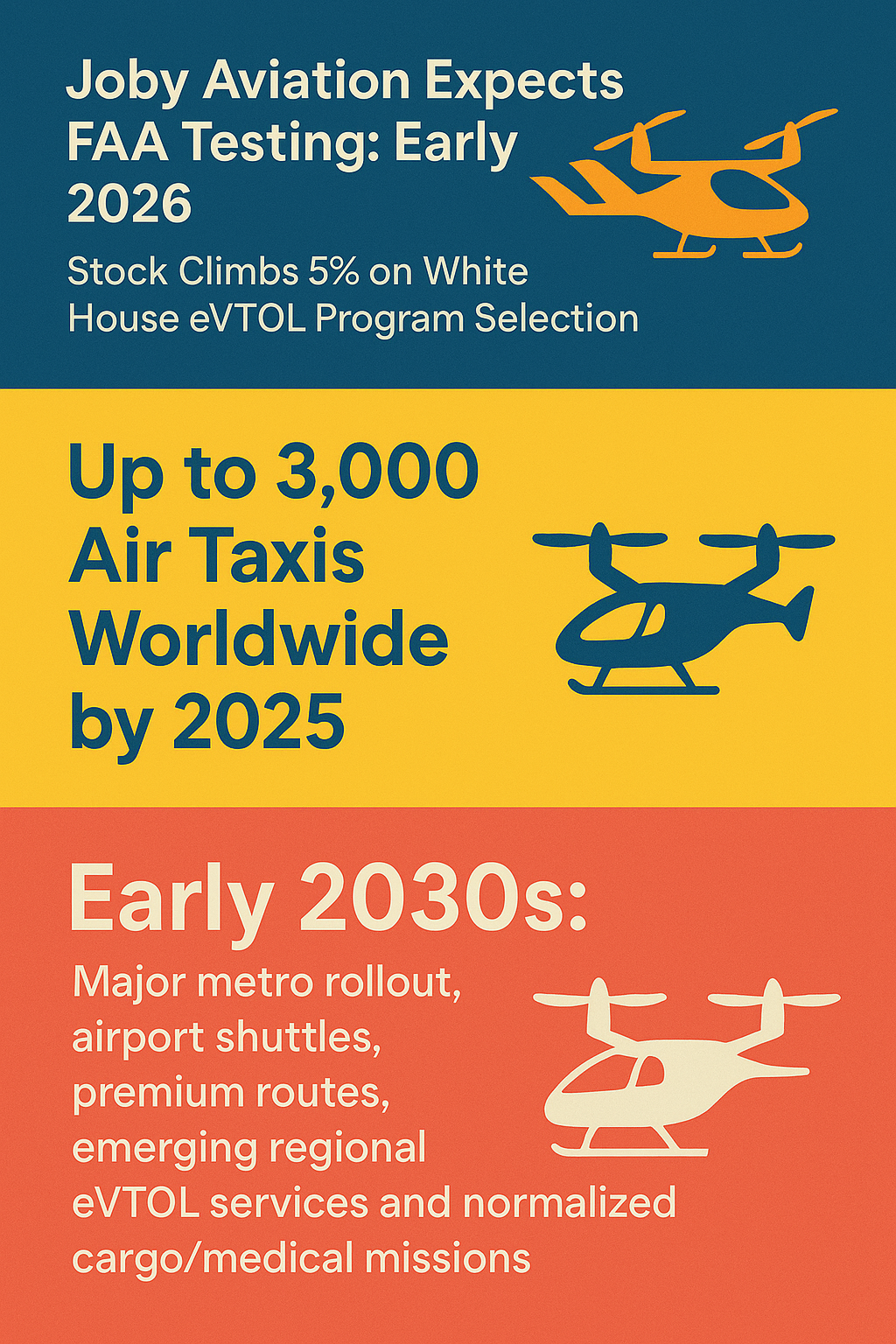Global Scans · MSL: Flying Taxis · Trend Tracker
Headline & Summary
Analysis of the recent evidence set reveals a clear acceleration in key signals within the flying taxi and urban air mobility (UAM) domain. Regulatory momentum, commercial partnerships, and infrastructure development are gaining rapid traction globally, with pronounced leadership from the U.S., UAE, South Korea, and China. Meanwhile, emerging challenges related to certification risks, public acceptance, and geopolitical competition are becoming more visible but remain largely stable in media presence. These patterns collectively indicate an imminent transformative phase for urban air mobility between 2025 and 2030, with early deployments in select cities and increasing investor interest shaping the near future.
Top Signals Monitoring Momentum
| Signal Name / Theme | Direction | Relative Frequency or % Change | Short Commentary |
|---|---|---|---|
| Regulatory Acceleration & Pre-Certification Operations | Accelerating | High frequency; surge in references from mid-2025 | FAA’s eVTOL Integration Pilot Program, early operational approvals, and national regulations (U.S., UAE, China) are enabling real-world testing ahead of full certification, crucially shortening time-to-market. |
| Strategic Commercial Partnerships and Market Entry | Accelerating | Significant increase in mentions since Q2 2025 | Notable agreements like Archer-Korean Air, Joby’s Uber integration, and Dubai’s six-year deal with Joby Aviation indicate expanding commercial footholds and market validation globally. |
| Infrastructure Development – Vertiports and Airspace Integration | Accelerating | Marked increase in infrastructure-related references in latest quarter | Rapid vertiport network planning in Dubai, Los Angeles, and South Korea coupled with airspace corridor mapping show forward movement on physical enablers for urban air mobility scale-up. |
| China’s Pilotless and Cargo-Focused eVTOL Expansion | Accelerating | Steady growth with rising media visibility in late 2025 | China leads in autonomous eVTOL deployments (e.g., EHang VT35), cargo flights, and domestic market scale, challenging Western pilots-on-board models and highlighting geopolitical-economic aviation competition. |
| Investor Interest & Funding Dynamics | Stable with upward pressure | Consistent mentions; highlighted by market volatility around Joby | Strong institutional-investor focus, demonstrated by share sales, stock volatility, and capital raises, show continued confidence balanced against certification and profitability risks. |
| Certification & Safety Risks | Stable | Consistent but no sharp increase | Regulatory hurdles remain a critical bottleneck but are increasingly framed as manageable with recent FAA, EASA, and CAAC rulemakings providing clearer pathways. |
Pattern Narrative
The confluence of regulatory acceleration and strategic partnerships signals a transformational driver for the flying taxi ecosystem. Governments and regulators have moved from conceptual planning to operational frameworks, enabling companies to initiate pilot programs and limited commercial operations even prior to final certification. This pre-certification operational approach is generating valuable data and public familiarity, catalyzing broader ecosystem growth.
Simultaneously, the growth in vertiport development projects and airspace management initiatives illustrates a systemic infrastructure buildout that is necessary to transition from isolated demo flights to integrated urban air mobility services. Regional leadership by markets like Dubai, Los Angeles, and Seoul reflects a competitive dynamic where early-mover advantages will be important.
China’s distinct push towards autonomous, cargo-oriented eVTOL services and its rapid certification wins point to geopolitical and technological competition influencing global industry trajectories. Western-centric pilot-on-board models compete with China’s pilotless innovations, shaping diverse regulatory and commercialization pathways.
Implications for Monitoring and Strategy
- Monitor regulatory developments closely: The speed and scope of regulatory approvals, especially the progress of FAA and CAAC type certifications, will be pivotal inflection points for market expansion and investor confidence.
- Prioritize infrastructure investment and coordination: Successful early deployments will hinge on well-executed vertiport siting, airspace integration, and public acceptance efforts. Cooperation with local municipalities and transport agencies is critical.
- Assess geopolitical competition and supply chain dependencies: China’s assertive approach and growing market share in pilotless eVTOL sectors require Western stakeholders to evaluate technology strategies and regulatory harmonization.
- Watch investor sentiment and capital flows: Financial markets remain cautious yet engaged. Certification milestones and commercial rollout successes will modulate capital availability and valuations among key players.
Signals Gaining Momentum Summary
- Regulatory Acceleration and Pre-Certification Testing – Strong increase in meaningful approvals and pilot programs globally, shortening commercialization timelines.
- Strategic Commercial Partnerships – Expansion of major market-entry deals and airline collaborations indicative of maturing market readiness.
- Vertiport and Airspace Infrastructure Buildout – Emergence of dedicated physical networks as a foundation for scalable urban air mobility services.
- China’s Autonomous eVTOL Expansion – Rising competitive pressure with pilotless passenger and cargo operations, signaling a divergent innovation path.
- Investor Engagement with Market Volatility – Balanced but sustained investor confidence amidst financial and operational risk acknowledgment.
These accelerating signals suggest a landscape preparing to shift from trial phases to early commercial deployment, with the current 2025–2028 window as the most critical inflection point. Stakeholders should focus on regulatory milestones, infrastructure readiness, and strategic partnerships to anticipate and influence successful market entry.
Sources include multiple news and industry analysis reports (e.g., ePlane AI, Zag Daily, BuyLakewoodRanch.com, ChinaDailyHK, Yahoo Finance, Infusive, among others).
